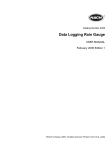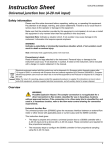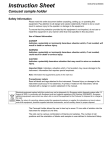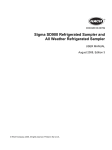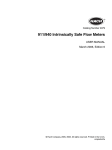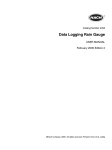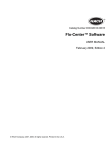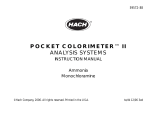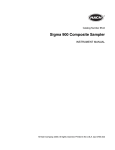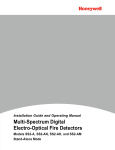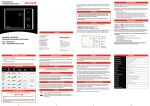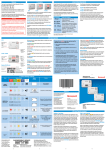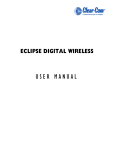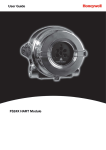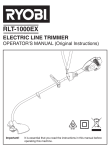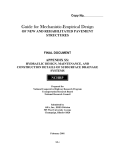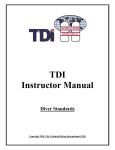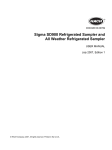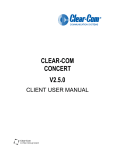Download Submerged Area/Velocity Sensor
Transcript
Catalog Number 7726018 Submerged Area/Velocity Sensor USER MANUAL September 2005 Edition 2 © Hach Company, 2005. All rights reserved. Printed in the U.S.A. eac//te/dp Visit us at www.hach.com Table of Contents Section 1 Specifications ........................................................................... 5 Section 2 General Information ................................................................. 7 2.1 Theory of Operation .............................................................................. 7 2.2 Sensor Overview ................................................................................... 7 Section 3 Installing the Sensor ................................................................ 9 3.1 Zeroing the Sensor ................................................................................ 9 3.2 Important Guidelines for Sensor Installation.......................................... 9 3.2.1 Proper Strain Relief of Sensor Cable ......................................... 10 3.3 Connecting the Sensor to the Mounting Bands ................................... 12 3.4 Placing the Sensor and Mounting Band into the Pipe ......................... 13 3.5 Compensating for Velocity Direction.................................................... 15 3.6 Performing a Level Adjustment............................................................ 16 Section 4 Sensor Maintenance............................................................... 17 4.1 Sensor Maintenance............................................................................ 17 4.1.1 Cleaning the Sensor (Oil-filled and Standard) ........................... 17 Cleaning the Sensor (Oil-filled and Non-oil) 17 4.1.2 Oil Replenishment (Oil Kit Cat. No. 7724800)............................ 19 4.2 Changing the Sensor Desiccant .......................................................... 21 4.2.1 Desiccant Replacement Procedure ........................................... 22 4.3 Hydrophobic Filter Description ............................................................ 23 4.4 Hydrophobic Filter Replacement Procedure........................................ 23 Section 5 Parts and Accessories .......................................................... 25 5.1 Group 77000 Series ............................................................................ 25 5.2 Oil-Filled Area Velocity Sensors with Bare Leads .............................. 25 5.3 Standard Area Velocity Sensors with Connectors .............................. 26 5.4 Standard Area Velocity Sensors with Bare Leads ............................... 26 5.5 Area Velocity Sensor Accessories....................................................... 27 Section 6 Contact Information for U.S.A. and Outside Europe ........... 29 Section 7 Contact Information for Europe ............................................ 30 Section 8 Limited Warranty .................................................................... 31 7726018TOC.fm Page 3 Visit us at www.hach.com Section 1 Specifications Specifications are subject to change without notice. Performance will vary depending on channel size, channel shape, and site conditions. Velocity Measurement For velocity performance specifications, refer to individual Sigma Automatic Sampler and Flow Meter specifications. Method Doppler Ultrasound Twin 1 MHz piezoelectric crystals Typical Minimum Depth 2 cm (0.8 in.) Recommended Range –1.52 to 6.10 m/s (–5 to 20 ft/s) Level Measurement Method Pressure transducer with stainless steel diaphragm Accuracy (static)1 ±0.16% full scale ±1.5% of reading at constant temp (± 2.5 °C) ±0.20% full scale ±1.75% of reading from 0 to 30 °C (32 to 86 °F) ±0.25% full scale ±2.1% of reading from 0 to 70 °C (32 to 158 °F) Velocity-Induced Depth Error Compensated based on pipe geometry and flow velocity. Level Range Standard: 0–3 m (0–10 ft) Extended: 0–9 m (0–30 ft) Allowable Level Standard: 10.5 m (34.5 ft) Extended: 31.5 m (103.5 ft) General Attributes 1 Air Intake Atmospheric pressure reference is desiccant protected. Operating Temperature Range 0 to 70 °C (32 to 158 °F) Level Compensated Temperature Range 0 to 70 °C (32 to 158 °F) Material Noryl® outer shell with epoxy potting within Power Consumption ≤1.2 W @ 12 VDC Cable Urethane sensor cable with air vent Connector Hard anodized; satisfies Military Spec 5015 Cable Lengths Available Standard: 9, 15, 23, and 30.5 m (30, 50, 75, and 100 ft) Custom: 30.75 m (101 ft) to 76 m (250 ft) maximum Cable Diameter 0.91 cm (0.36 in.) Dimensions 2.3 cm H x 3.8 cm W x 13.5 cm L (0.9 in. H x 1.5 in. W x 5.31 in. L) Compatible Instruments 910, 920, 930, 930 T, 950, 980, 900 Max, 900 Max Refrigerated Samplers, and 900 AWRS For temperatures above 40 °C (104 °F) add ± 0.3 cm/°C (0.03 in./°F) 7726018specs.fm Specifications Page 5 Visit us at www.hach.com Section 2 General Information 2.1 Theory of Operation The Submerged Area/Velocity Sensor contains a pressure transducer for level measurement and a pair of ultrasonic transducers for velocity measurement. These two measurements are used to calculate flow in open channels. The flow meter measures the pressure of the water and converts it into a level reading. The “wetted area” of the flow stream is then calculated using this level reading and the user-entered channel geometry. The flow meter then measures the Doppler shift in returned ultrasound and converts it into a velocity reading. The “wetted area” multiplied by the velocity equals the flow rate. 2.2 Sensor Overview The sensor is available in two versions (Figure 1). The Non-oil sensor is used for reasonably clear sites or in sites where the pipe can become dry. The Oil-filled sensor is used for sites with high levels of biological growth, grit, or silt. Do not use the Oil-filled sensor in a pipe that may become dry. Figure 1 Non-oil and Oil-filled Sensors 1 1. Non-oil Sensor 7726018geninfo.fm 2 2. Oil-filled Sensor General Information Page 7 Visit us at www.hach.com Section 3 Installing the Sensor 3.1 Zeroing the Sensor The sensor has been factory-calibrated and compensated for temperature. The sensor needs to be zeroed during each installation, but does not require calibration. The sensor should be zeroed when moving it from one flow meter or sample to another. To zero the sensor: 1. Install InSight version 5.7 or greater and start the program. 2. From the InSight software menu, select Remote Programming. 3. From the Real Time Operations list, select the level sensor to be calibrated. 4. Remove the probe from the liquid and place the sensor flat on the tabletop or floor with the sensor (the plate with the holes) facing down onto the surface. 5. Press OK on the dialog box when complete. 3.2 Important Guidelines for Sensor Installation • Do not install more than one sensor at a time in pipes less than 61 cm (24 inches). Multiple sensors in smaller pipes can create turbulent or accelerated flows near the sensors that may cause inaccurate measurements. • Mount the sensor as close as possible to the bottom of the pipe invert to most accurately measure low velocity levels. • Do not monitor flows in the invert of the manhole itself. The best sensor location is 3 to 5 times the sewer diameter/height upstream of the invert. • Locate monitoring sites as far from inflow junctions as possible to avoid interference caused by combined flows. • Avoid sites that contain flow obstacles within 2 to 4 pipe diameters in front of the sensor installation (rocks, stones, pipe joints, valve stems, etc.) as these will contribute to turbulence and generate high speed flows in the immediate vicinity of the obstruction. 7726018install.fm Installing the Sensor Page 9 Important Guidelines for Sensor Installation • Avoid any sites with slow moving flows that will encourage the buildup of silt in the invert or channel. Excessive silting around the sensor may inhibit the Doppler signal and decrease sensor accuracy, and may affect depth measurement accuracy. • Avoid sites with deep, rapid flows that will make it physically difficult or dangerous to install the sensor. • Avoid sites with high velocity, low-depth flows. Splash-over and excessive turbulence will be present around the sensor and data may be inaccurate. 3.2.1 Proper Strain Relief of Sensor Cable Attach the desiccant hub to the instrument handle to provide a strain relief for the sensor cable and connector (Figure 2). Important Guidelines for Sensor Installation Page 10 7726018install.fm Important Guidelines for Sensor Installation Figure 2 Proper Strain Relief 1. Lanyard 3. Desiccant Hub 2. Carabineer 4. Flow Meter 7726018install.fm Important Guidelines for Sensor Installation Page 11 Connecting the Sensor to the Mounting Bands 3.3 Connecting the Sensor to the Mounting Bands Important Note: If using an oil-filled sensor, replenish the oil prior to mounting the sensor to a mounting band. Refer to section 4.1.2 on page 19 for oil replenishment instructions, if applicable. 1. Attach the sensor to the spring ring. Mounting bands come with pre-drilled holes for direct mounting of the sensor to the band. 2. To reduce the likelihood of debris collecting on the cable and mounting band, route the cable along the edge of the band and fasten the cable to the mounting band with nylon wire ties (Figure 3). The cable should exit the tied area at, or near, the top of the pipe to keep it out of the flow stream. Note: If there is a large amount of silt in the bottom of the pipe, rotate the band until the sensor is out of the silt (Figure 4), assuring that the sensor remains below the minimum expected water level at all times. Silt should not be disturbed and must be measured frequently. Figure 3 Attaching the Sensor to the Mounting Band 1 4 2 3 1. Spring Ring 3. Screws (2) 2. Sensor 4. Nylon Wire Ties Connecting the Sensor to the Mounting Bands Page 12 7726018install.fm Placing the Sensor and Mounting Band into the Pipe Figure 4 Avoiding Silt when Mounting the Sensor 3 1 4 2 1. Water 2. Silt 3. Pipe 4. Sensor 3.4 Placing the Sensor and Mounting Band into the Pipe Point the angle-face of the sensor into the flow. The manufacturer recommends placing the sensor with the arrow pointing with the flow (Figure 5). For other mounting configurations, see the appropriate flow meter manual. Slide the mounting band as far into the pipe as possible to eliminate drawdown effects near the end of the pipe. Locate the sensor at the bottom-most point in the channel. If excessive silt is present on the bottom of the pipe, rotate the band in the pipe until the sensor is out of the silt. 7726018install.fm Placing the Sensor and Mounting Band into the Pipe Page 13 Placing the Sensor and Mounting Band into the Pipe Figure 5 Placing the Sensor into the Flow Manhole Velocity Sensor Normal Upstream Position Manhole Velocity Sensor Downstream Position Placing the Sensor and Mounting Band into the Pipe Page 14 7726018install.fm Compensating for Velocity Direction 3.5 Compensating for Velocity Direction When programming the sensor the following may be selected: Option1 Upstream (recommended for most applications) Description Use this option at sites with fairly consistent velocities, and low to medium turbulence. The flow stream over the sensor should be relatively straight, with no drops or turns near the measurement point. Mount the sensor in the pipe, beveled edge facing into the flow, where the flow stream enters the measurement area (Figure 5). Use this option when the sensor is installed downstream of the measurement point (where the flow stream exits the site). This option is useful when more than one flow stream enters a site and the combined flow of all streams at a single exit point is measured. Downstream Mount the sensor in the downstream direction rather than the typical, upstream direction. Mounting the sensor 'backwards' in this manner (Figure 5) causes the velocity direction readings to be the opposite of actual stream flow. By selecting the Downstream choice when programming, the logger reverses the measured signal to show actual flow direction (beveled edge downstream). The maximum velocity obtained in this type of installation is 5 fps. 1 Additional options may be available depending on the flow meter or sampler used. Refer to the appropriate flow meter or sampler manual for more information. 7726018install.fm Compensating for Velocity Direction Page 15 Performing a Level Adjustment 3.6 Performing a Level Adjustment The manufacturer recommends doing a level adjustment whenever a sensor is first installed into a flow stream. This adjustment accounts for the various physical tolerance stack-ups in the system (i.e., thickness of the mounting band, angular placement of the sensor relative to the “6 O’ clock” position in the pipe, etc.) 1. With the sensor installed in the flow, use a PC or display (950 and 980 flowmeter) to monitor Current Status. 2. Take a physical measurement of the water depth by measuring the distance from the top of the pipe to the surface of the water (item B, Figure 6), and subtracting this number from the pipe diameter (item A, Figure 6). The resulting number is the water depth (item C, Figure 6). 3. Enter the physically-measured water depth into the software using the Adjust Level function. Figure 6 Measuring the Water Level B A C Performing a Level Adjustment Page 16 7726018install.fm Section 4 Sensor Maintenance 4.1 Sensor Maintenance 4.1.1 Cleaning the Sensor (Oil-filled and Standard) Clean the transducer port when: • Unexpected increase or decrease in flow or level trend occurs • Level data are missing or incorrect but velocity data are valid. • Excessive silt has deposited between the transducer and its protective cover. 4.1.1.1 Cleaning the Sensor (Oil-filled and Non-oil) Important Note: Do NOT interchange an oil-filled protective cover plate with a non-oil cover plate. This will adversely affect level readings. It is possible to convert one type of sensor to the other using the Oil Probe Conversion Kit (Cat. No. 7730000), refer to the Oil Probe Conversion Kit Instruction Sheet, Cat. No. 7730089 for more information. Important Note: When cleaning the transducer, use the most gentle technique possible. Do not use sharp or pointed objects to remove sediment from the face of the transducer. If you nick or dent the transducer, it will break! 1. Soak the sensor in soapy water Note: Do not soak the sensor in bleach. Bleach will permanently damage the sensor. Refer to Table 1 for acceptable cleaning solutions. Table 1 Cleaning Solutions Acceptable Unacceptable Dish Detergent and Water Concentrated Bleach Window Cleaner Kerosene Isopropyl Alcohol Gasoline Dilute Acids Aromatic Hydrocarbons 2. Remove the screws from the protective cover (Figure 7). 3. Remove the cover and gasket. 4. Carefully swirl the sensor in an appropriate cleaning solution to remove soil. Use a spray or squeeze bottle to wash away heavier deposits. 5. Clean the gasket and cover. Replace the gasket (Cat. No. 7722000) if it is torn or damaged. Level readings will be adversely affected if the gasket is damaged or not installed. 6. Reattach the gasket and cover (note orientation in Figure 7). Tighten the screws until the gasket starts to compress. 7726018maint.fm Sensor Maintenance Page 17 Sensor Maintenance 7. If using an oil-filled sensor, continue to Oil Replenishment (Oil Kit Cat. No. 7724800) on page 19. Figure 7 Removing the Protective Cover (Non-Oil Sensor) 2 1 3 4 5 1. Sensor 4. Gasket 2. Screws (#6–32 x 5/16) 5. Pressure Transducer 3. Protective Cover Sensor Maintenance Page 18 7726018maint.fm Sensor Maintenance Figure 8 Removing the Protective Cover (Oil-filled Sensor) 2 3 1 4 5 6 1. Sensor 2. Screws (#6–32 x 3. Protective Cover 4.1.2 5/16) 4. Screw, set, #2-56 5. Gasket 6. Pressure Transducer Oil Replenishment (Oil Kit Cat. No. 7724800) The manufacturer recommends inspecting the oil in the sensor for large air bubbles during the customer-scheduled service duty cycle, and prior to every installation. Small bubbles (less than ¼-in. diameter) of air within the oil do not affect performance. Larger bubbles may minimize the anti-fouling benefit of the oil. To replenish sensor oil: 1. If the sensor is new, remove the yellow tape on the sensor. 2. Remove any debris from the sensor. 3. Load the oil cartridge into the dispensing gun (Figure 9). 4. Twist the feed tube onto the cartridge and attach the syringe tip to the feed tube (Figure 10). 5. Press the dispenser gun handle to purge any air bubbles from the syringe tip. 7726018maint.fm Sensor Maintenance Page 19 Sensor Maintenance 6. Remove the set screw in the transducer cover with the supplied 0.035 hex wrench. Retain the set screw. 7. Slowly insert the syringe tip into the set screw hole and dispense the oil (Figure 11). While dispensing the oil, hold the probe at an angle to allow the air to be pushed out the side port (Figure 11). Continue to dispense the oil until all the air bubbles are removed. Note: Slowly insert the syringe tip and do not dispense oil during insertion or damage to the transducer may occur if too much pressure is applied. 8. Continue to dispense the oil while removing the syringe from the set screw hole to prevent air bubbles. Replace the set screw until it is flush with the transducer cover and remove any excess oil around the screw hole or on the sensor. 9. Clean the entire probe and place a piece of electrical tape over the side port to prevent oil from leaking out. Remove the tape from the sensor prior to zeroing and installing the sensor. Figure 9 Loading the Cartridge into the Dispensing Gun 1 1. Dispensing Gun Figure 10 2 2. Silicone Oil Cartridge Attaching the Feed Tube and Syringe Sensor Maintenance Page 20 7726018maint.fm Sensor Maintenance Figure 11 Oil Replenishment 1 3 2 4 1. Sensor 3. Side port 2. Set screw 4. Syringe 4.2 Changing the Sensor Desiccant The desiccant canister contains beads of silica gel which ensure proper orientation of the pressure transducer. When the beads are blue, they can remove moisture from the air. When they are pink, they are saturated and cannot absorb any more moisture from the air, and they must be replaced immediately. Important Note: When the beads begin to turn pink, replace or rejuvenate the beads. Permanent damage to the sensor may occur if the desiccant is not maintained. Never operate the sensor without the proper desiccant. When rejuvenating beads, remove them from the canister and heat at 100–180 °C (212–350 °F) until the beads turn blue. If the beads do not turn blue, replace them with new beads. Do not heat the canister. 7726018maint.fm Changing the Sensor Desiccant Page 21 Sensor Maintenance 4.2.1 Desiccant Replacement Procedure Note: Replacing the desiccant does not require that the desiccant container be removed from the desiccant box. 1. Use a slight twisting motion to twist the bottom end-cap until its slots align with the retaining clips (Figure 12). 2. Gently remove the end cap by grasping it and pulling it straight out. 3. Pour the desiccant beads out of the canister. 4. Hold the canister up to the light and inspect the hydrophobic filter. • If you see a small, dim light spot while looking through the hole, the filter is in good condition. If you see a bright light spot, the filter is probably torn. Replace the filter. • If the desiccant beads were completely saturated with water or the filter has saturated with water or grease, replace the filter. 5. Refill the canister tube with blue desiccant beads (Cat. No. 3624). Inspect the O-ring (Cat. No. 5252) on the bottom cap for cracking, pits, or evidence of leakage. Replace if necessary. Note: Applying O-ring grease to new or dry O-rings improves the ease of insertion, sealing, and life span of the O-ring. 6. Make sure that the O-ring is clean and free of dirt or debris before replacing the end cap. 7. Reinstall the end cap. Figure 12 1. Removing the Bottom End Cap End Cap Changing the Sensor Desiccant Page 22 2. Desiccant Container 7726018maint.fm Sensor Maintenance 4.3 Hydrophobic Filter Description A single Teflon® hydrophobic filter (Cat. No. 3390) is installed in the top of the canister to prevent liquid from entering the vent tube. For best performance and to avoid grease buildup on the filter during submergence or surcharge conditions, hang the canister vertically so that the end facing the sensor points downward. Note: The Hydrophobic Filter may need replacement at any time the cartridge is submerged or exposed to excess moisture. Refer to section 4.4. 4.4 Hydrophobic Filter Replacement Procedure 1. Disconnect the tubing from the top of the desiccant canister. 2. Unscrew the hex-head tubing nipple from the top of the canister and discard the old filter. 3. Discard any remnants of Teflon tape from the nipple’s threads. Reapply two turns of Teflon tape (Cat. No. 10851-45) to the threads, pulling the tape into the threads until it conforms to the shape of the threads. 4. Place a new filter over the hole. Make sure that the smooth side of the filter faces the inside of the canister (Figure 13). 5. Place the threaded nipple on top of the filter. 6. With a slight pressure, press the filter into the hole with the nipple threads and begin threading the nipple into the hole. The filter will deflect upward and feed completely into the thread until it disappears. The filter must rotate with the nipple as it is threaded into the cap. If it does not, it is torn. Start over with a new filter. 7. Inspect the installation. In the upper cap, a small, dim light spot should be visible when held up to the light. A bright spot indicates a torn filter. Start over with a new filter. Figure 13 Replacing the Hydrophobic Filter 1 1. Filter, smooth side down 7726018maint.fm 3 2 2. Hex-head tubing nipple 3. Finished assembly. Hydrophobic Filter Description Page 23 Visit us at www.hach.com Section 5 Parts and Accessories 5.1 Group 77000 Series Description Depth Cat. No. Oil-Filled Submerged AV Sensor, 0–10 ft range, 30 ft cable, with connector 0–10 ft 77064-030 Oil-Filled Submerged AV Sensor, 0–10 ft range, 50 ft cable, with connector 0–10 ft 77064-050 Oil-Filled Submerged AV Sensor, 0–10 ft range, 75 ft cable, with connector 0–10 ft 77064-075 Oil-Filled Submerged AV Sensor, 0–10 ft range, 100 ft cable, with connector 0–10 ft 77064-100 Oil-Filled Submerged AV Sensor, 0–10 ft range, custom cable, with connector 0–10 ft 77064-XXX Oil-Filled Submerged AV Sensor, 0–30 ft range, 30 ft cable, with connector 0–30 ft 77074-030 Oil-Filled Submerged AV Sensor, 0–30 ft range, 50 ft cable, with connector 0–30 ft 77074-050 Oil-Filled Submerged AV Sensor, 0–30 ft range, 75 ft cable, with connector 0–30 ft 77074-075 Oil-Filled Submerged AV Sensor, 0–30 ft range, 100 ft cable, with connector 0–30 ft 77074-100 Oil-Filled Submerged AV Sensor, 0–30 ft range, custom cable, with connector 0–30 ft 77074-XXX 5.2 Oil-Filled Area Velocity Sensors with Bare Leads Description Depth Cat. No. Oil-Filled Submerged AV Sensor, 0–10 ft range, 30 ft cable, with bare leads for barrier box 0–10 ft 77264-030 Oil-Filled Submerged AV Sensor, 0–10 ft range, custom cable, with bare leads for barrier box 0–10 ft 77264-XXX Oil-Filled Submerged AV Sensor, 0–30 ft range, 30 ft cable, with bare leads for barrier box 0–30 ft 77274-030 Oil-Filled Submerged AV Sensor, 0–30 ft range, custom cable, with bare leads for barrier box 0–30 ft 77274-XXX 7726018parts.fm Parts and Accessories Page 25 Standard Area Velocity Sensors with Connectors 5.3 Standard Area Velocity Sensors with Connectors Description Depth Cat. No. Submerged AV Sensor, 0–10 ft range, 30 ft cable, with connector 0–10 ft 77065-030 Submerged AV Sensor, 0–10 ft range, 50 ft cable, with connector 0–10 ft 77065-050 Submerged AV Sensor, 0–10 ft range, 75 ft cable, with connector 0–10 ft 77065-075 Submerged AV Sensor, 0–10 ft range, 100 ft cable, with connector 0–10 ft 77065-100 Submerged AV Sensor, 0–30 ft range, custom cable, with connector 0–10 ft 77065-XXX Submerged AV Sensor, 0–30 ft range, 30 ft cable, with connector 0–30 ft 77075-030 Submerged AV Sensor, 0–30 ft range, 50 ft cable, with connector 0–30 ft 77075-050 Submerged AV Sensor, 0–30 ft range, 75 ft cable, with connector 0–30 ft 77075-075 Submerged AV Sensor, 0–30 ft range, 100 ft cable, with connector 0–30 ft 77075-100 Submerged AV Sensor, 0–30 ft range, custom cable, with connector 0–30 ft 77075-XXX 5.4 Standard Area Velocity Sensors with Bare Leads Description Depth Cat. No. Submerged AV Sensor, 0–10 ft range, 30 ft cable, with bare leads for barrier box 0–10 ft 77265-030 Submerged AV Sensor, 0–10 ft range, custom cable, with bare leads for barrier box 0–10 ft 77265-XXX Submerged AV Sensor, 0–30 ft range, 30 ft cable, with bare leads for barrier box 0–30 ft 77275-030 Submerged AV Sensor, 0–30 ft range, custom cable, with bare leads for barrier box 0–30 ft 77275-XXX Standard Area Velocity Sensors with Connectors Page 26 7726018parts.fm Area Velocity Sensor Accessories 5.5 Area Velocity Sensor Accessories Description Cat. No. Custom cable connecting sensor to junction box. Cable lengths range from 1–99 ft 77155-PRB Custom cable connecting junction box to hub. Cable lengths range from 1–99 ft 77155-HUB Hub Assembly for Bare Wire 77228-00 Silicon oil dual 50-mL oil pack only. Refills 100 sensors 7724700 Silicon oil refill kit includes dispensing tool, dual 50-mL oil pack, instruction sheet and miscellaneous hardware. Refills 100 sensors 7724800 Instruction Sheet, Oil Fill Kit 7724789 Instruction Sheet, Bare Wire AV Probe 7725089 Instruction Sheet, Firmware Upgrade 7726089 Silicon Potting Gel Kit 7725600 Gel Fill (order three to fill a single junction box) 7729800 Gel Fill Dispensing Gun (also doubles as silicone oil fill gun) 7715300 Retrofit kit for transforming a sensor with a non-oil cover plate into Oil filled cover plate. Includes kit 77248-00 7730000 7726018parts.fm Area Velocity Sensor Accessories Page 27 Visit us at www.hach.com Section 6 Contact Information for U.S.A. and Outside Europe Ordering Information for the U.S.A. By Telephone: By Mail: 6:30 a.m. to 5:00 p.m. MST Monday through Friday (800) 227-HACH (800)-227-4224 By Fax: Hach Company P.O. Box 389 Loveland, Colorado 80539-0389 U.S.A Ordering information by E-mail: (970) 461-3914 [email protected] Information Required • Hach account number (if available) • Billing address • Your name and phone number • Shipping address • Purchase order number • Catalog number • Brief description or model number • Quantity Ordering Information for Outside the U.S.A. and Europe Hach Company maintains a worldwide network of dealers and distributors. To locate the representative nearest you, send e-mail to [email protected] or visit www.hach.com. Technical Support Technical and Customer Service Department personnel are eager to answer questions about our products and their use. In the U.S.A., call 1-800-227-4224 or email [email protected]. Outside the U.S.A. and Europe, send e-mail to [email protected]. Repair Service Authorization must be obtained from Hach before sending any items for repair. Please contact the Hach Service Center serving your location. Hach Company P.O. Box 389 Loveland, Colorado, 80539-0389 U.S.A. Telephone: 1-800-635-4567 or (970) 669-3050 Fax: (970) 669-2932 7226018contact.fm Contact Information for U.S.A. and Outside Europe Page 29 Section 7 Contact Information for Europe For technical support, repair service, and ordering information please refer to the contact information below for your specific country. For additional information, visit www.hach-lange.com. Austria Dr. Bruno Lange Ges. MBH Industriestraße 12 A - 3200 Obergrafendorf Tel. +43 (0)27 47 74 12 Fax +43 (0)27 47 42 18 [email protected] Germany Dr. Bruno Lange GmbH & CO. KG Willstätterstr. 11 D-40549 Düsseldorf Tel. +49 (0)2 11 52 88-0 Fax +49 (0)2 11 52 88-143 [email protected] The Netherlands Dr. Lange Nederland B.V. Laan an Westroijen 2a NL-4003 AZ Tiel Tel. +31 (0) 3 44 63 11 30 Fax +31 (0) 3 44 63 11 50 [email protected] Belgium Dr. Lange Motstraat 54 B-2800 Mechelen Tel. +32 (0)15 42 35 00 Fax +32 (0)15 41 61 20 [email protected] Great Britain Hach Lange LTD Lennox Road Basingstoke Hampshire, RG22 4AP Tel. +44 (0)12 56 33 34 03 Fax +44 (0)12 56 33 07 24 [email protected] Spain/Portugal Hach Lange S.L.U. c/ Araba, 45. Apdo. 220 E-20800 Zarauz/Guipùzcoa Tel. +34 9 43 89 43 79 Fax +34 9 43 13 02 41 [email protected] Denmark Dr. Lange Danmark A/S Jernhoolmen 34-40 DK-2650 Hvidovre Tel. +45 (0)36 77 29 11 Fax +45 (0)36 77 49 11 [email protected] Italy Dr. Bruno Lange s.r.I. Via Riccione, 14 I-20156 Milano Tel. +39 02 39 23 14-1 Fax +33 02 39 23 14-39 [email protected] Sweden Hach Lange AB Vinthundsvägen 159A S-128 62 Sködal Tel. +46 (0)8 7 98 05 00 Fax +46 (0)8 7 98 05 03 [email protected] France Hach Lange Hach SAS 33 Rue du Ballon F-93165 Noisy Le Grand Tel. +33 (0)1 48 15 80 80 Fax +33 (0)1 48 15 80 00 [email protected] Poland Hach Lange sp.zo.o. ul. Opolska 143 a PL-52-013 Wroclaw Tel. +48 71 3 42 10 -81 Fax +48 71 3 42 10-79 [email protected] Switzerland Dr. Bruno Lange AG Juchstrasse 1 CH-8604 Hegnau Tel. +41(0)1 9 45 66 10 Fax +41(0)1 9 45 66 76 [email protected] Contact Information for Europe Page 30 7226018contact.fm Section 8 Limited Warranty Hach Company warrants its products to the original purchaser against any defects that are due to faulty material or workmanship for a period of one year from date of shipment unless otherwise noted in the product manual. In the event that a defect is discovered during the warranty period, Hach Company agrees that, at its option, it will repair or replace the defective product or refund the purchase price excluding original shipping and handling charges. Any product repaired or replaced under this warranty will be warranted only for the remainder of the original product warranty period. This warranty does not apply to consumable products such as chemical reagents; or consumable components of a product, such as, but not limited to, lamps and tubing. Contact Hach Company or your distributor to initiate warranty support. Products may not be returned without authorization from Hach Company. Limitations This warranty does not cover: • Damage caused by acts of God, natural disaster, labor unrest, acts of war (declared or undeclared), terrorism, civil strife or acts of any governmental jurisdiction • Damage caused by misuse, neglect, accident or improper application or installation • Damage caused by any repair or attempted repair not authorized by Hach Company • Any product not used in accordance with the instructions furnished by Hach Company • Freight charges to return merchandise to Hach Company • Freight charges on expedited or express shipment of warranted parts or product • Travel fees associated with on-site warranty repair This warranty contains the sole express warranty made by Hach Company in connection with its products. All implied warranties, including without limitation, the warranties of merchantability and fitness for a particular purpose, are expressly disclaimed. Some states within the United States do not allow the disclaimer of implied warranties and if this is true in your state the above limitation may not apply to you. This warranty gives you specific rights, and you may also have other rights that vary from state to state. This warranty constitutes the final, complete, and exclusive statement of warranty terms and no person is authorized to make any other warranties or representations on behalf of Hach Company. Limitation of Remedies The remedies of repair, replacement or refund of purchase price as stated above are the exclusive remedies for the breach of this warranty. On the basis of strict liability or under any other legal theory, in no event shall Hach Company be liable for any incidental or consequential damages of any kind for breach of warranty or negligence. 7226018contact.fm Limited Warranty Page 31 Visit us at www.hach.com
































